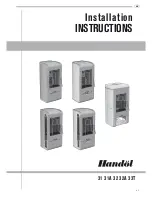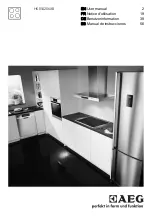
39
5
823
1
10a
15
NOTES ON FIREWOOD
Logs up to 18 inches in length (for Stanford 80 & Harmony I) or 22 inches in
length (for Stanford 140 & Harmony III) allow for better stacking, filling and
operation of your stove.
Use dry wood which by definition must be wood which has been dried under
cover for more than 18 months, in which case the logs contain less than 20%
moisture.
•
DO NOT USE FUELS OTHER THAN SEASONED WOOD.
•
NEVER USE GASOLINE, GASOLINE-TYPE LANTERN FUEL,
KEROSENE, CHARCOAL LIGHTER FLUID, OR SIMILAR LIQUIDS TO
START OR “FRESHEN UP” A FIRE IN THIS HEATER. KEEP ALL
SUCH LIQUIDS WELL AWAY FROM THE HEATER WHILE IN USE.
•
DO NOT BURN TRASH, GARBAGE OR FLAMMABLE FLUIDS SUCH
AS GASOLINE, NAPHTHA OR ENGINE OIL.
Heating the air in a closed building decreases the relative humidity of the air,
which will dry wood and other combustible materials. This drying lowers the
ignition temperature of these materials, thus increasing the
fire hazard. To
reduce the risk of fire, some provision should be made for replenishing
moisture to the air whenever a structure is being heated for extended periods.
What is the best wood for the fire?
Some types of wood are easier to light than others.
The best fire wood is always the driest wood.
Using dry wood will minimize creosote build-up.
What are the drawbacks of damp wood?
Damp wood has far less heating power. This lowers the combustion
temperature of the fire, and therefore the output. It is difficult to light, burns
badly and gives off smoke.
Above all the use of damp wood causes the formation of deposits (tarring and
soot staining) in the chimney flue and on the glass door.
Flue gas temperature
The most important aspect of stove operation is maintaining a high
combustion temperature. If the combustion of the fuel is at the correct
temperature, most of the soot and tars (hydrocarbons) are burned. These
hydrocarbons, when not burned, can be seen as tar and creosote deposits on
the internal surfaces of the stove, glass and chimney surfaces. To assist in
maintaining these temperatures, a surface mounted stove thermometer is
recommended.
High combustion temperatures are the secret to clean glass operation. When
loading wood, add one or two logs at a time, depending on size. Loading the
Содержание HARMONY I
Страница 5: ...395823110a 5 Combustion System Stanford 80 and Harmony I...
Страница 6: ...395823110a 6 Combustion System Stanford 140 and Harmony III...
Страница 11: ...395823110a 11...













































